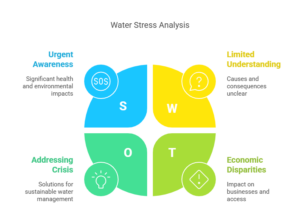Water stress refers to the situation where the water demand exceeds the available supply or when poor quality restricts its use. This phenomenon can arise from various factors, including climate change, population growth, and inefficient water management practices. Climate change, in particular, has been a significant driver of water stress, as it alters precipitation patterns and increases the frequency and intensity of droughts.
Additionally, urbanization and industrialization have led to increased water consumption, further exacerbating the strain on freshwater resources. The consequences of water stress are profound and multifaceted. On a human level, it can lead to health issues due to inadequate access to clean drinking water and sanitation facilities.
Contaminated water sources can result in the spread of waterborne diseases, which disproportionately affect vulnerable populations. Environmentally, water stress can lead to the degradation of ecosystems, loss of biodiversity, and reduced agricultural productivity. The interplay between these causes and consequences creates a cycle that is difficult to break, necessitating urgent attention and action.
Key Takeaways
- Water stress has significant impacts on human health, the environment, and food security.
- Understanding the causes and consequences of water stress is crucial for addressing the global water crisis.
- The implications of water stress on human health and the environment are far-reaching and require urgent attention.
- Droughts and water scarcity have a direct impact on agriculture and food security, posing challenges for sustainable food production.
- Water stress also has economic and social implications, affecting businesses, industries, and creating disparities in access to clean water.
The Global Water Crisis: Implications for Human Health and the Environment
The global water crisis is a pressing issue that affects billions of people worldwide. According to the United Nations, approximately 2 billion people live in countries experiencing high water stress. This crisis has dire implications for human health, as lack of access to clean water can lead to malnutrition, disease, and even death.
For instance, in regions like sub-Saharan Africa, where water scarcity is prevalent, children are particularly vulnerable to diseases such as cholera and dysentery, which thrive in unsanitary conditions. From an environmental perspective, the global water crisis poses significant threats to ecosystems. Rivers, lakes, and wetlands are being depleted at alarming rates due to over-extraction for agricultural and industrial use.
This depletion not only affects aquatic life but also disrupts the natural balance of ecosystems that rely on consistent water levels. Furthermore, the loss of wetlands diminishes their ability to filter pollutants and provide habitat for wildlife, leading to a cascade of negative effects on biodiversity.
Water Stress and Food Security: How Droughts and Scarcity Affect Agriculture
Water stress has a direct impact on food security, as agriculture is heavily reliant on adequate water supply for crop production. Droughts, which are becoming more frequent due to climate change, can devastate harvests and lead to food shortages. For example, the severe droughts experienced in California over the past decade have significantly reduced yields of key crops such as almonds and tomatoes, leading to increased prices and food scarcity in both local and global markets.
Moreover, water scarcity affects not only crop production but also livestock farming. Animals require substantial amounts of water for drinking and maintaining health; thus, when water is scarce, farmers may face difficult decisions regarding herd sizes or even culling livestock. This situation can lead to economic losses for farmers and contribute to rising food prices, further exacerbating food insecurity for populations that rely on affordable access to nutritious food.
Economic Impact of Water Stress: Challenges for Businesses and Industries
| Metrics | Data |
|---|---|
| Water Stress Level | High |
| Impact on Businesses | Decreased productivity |
| Impact on Industries | Increased production costs |
| Water-related Risks | Supply chain disruptions |
| Adaptation Strategies | Water-efficient technologies |
The economic ramifications of water stress extend beyond agriculture; they permeate various sectors including manufacturing, energy production, and tourism. Industries that rely heavily on water for their operations face significant challenges when water becomes scarce or expensive. For instance, the energy sector often requires substantial amounts of water for cooling processes in power plants.
In regions experiencing drought, energy production can be hampered, leading to increased operational costs and potential power shortages. Additionally, businesses may encounter reputational risks associated with their water usage practices. Companies that fail to implement sustainable water management strategies may face backlash from consumers and investors who prioritize environmental responsibility.
This shift in consumer behavior can lead to decreased sales and market share for businesses that do not adapt to the growing demand for sustainable practices. As such, addressing water stress is not only an environmental imperative but also a critical economic consideration for industries worldwide.
Water Stress and Social Inequality: Disparities in Access to Clean Water
Water stress exacerbates social inequalities by disproportionately affecting marginalized communities that often lack access to clean water resources. In many developing countries, impoverished populations are forced to rely on contaminated sources for their daily needs due to inadequate infrastructure and investment in water supply systems. This situation perpetuates a cycle of poverty, as poor health outcomes from contaminated water can hinder educational and economic opportunities.
Furthermore, social inequality manifests in the allocation of water resources within countries. Wealthier regions or individuals may have better access to clean water due to political influence or economic power, while poorer areas suffer from neglect. This disparity can lead to social unrest and conflict over water resources, highlighting the urgent need for equitable policies that ensure all communities have access to safe and sufficient water supplies.
Solutions to Water Stress: Innovations and Policies for Sustainable Water Management
Addressing water stress requires a multifaceted approach that includes innovative technologies and effective policies aimed at sustainable water management. One promising solution is the implementation of advanced irrigation techniques such as drip irrigation or rainwater harvesting systems that optimize water use in agriculture. These methods not only conserve water but also enhance crop yields by delivering precise amounts of moisture directly to plant roots.
On a policy level, governments must prioritize investments in infrastructure that improve access to clean water and promote conservation efforts. Integrated Water Resource Management (IWRM) is an approach that encourages collaboration among stakeholders at all levels—government agencies, local communities, and private sectors—to develop comprehensive strategies for managing water resources sustainably. By fostering cooperation and innovation, societies can work towards mitigating the impacts of water stress effectively.
The Future of Water Stress: Projected Trends and Potential Solutions
Looking ahead, projections indicate that water stress will continue to intensify due to ongoing climate change, population growth, and urbanization trends. The United Nations estimates that by 2025, two-thirds of the global population may face water-stressed conditions if current consumption patterns persist. This scenario underscores the urgency for immediate action in addressing both the causes and consequences of water stress.
Potential solutions lie in embracing technological advancements such as desalination plants that convert seawater into potable water or wastewater recycling systems that treat used water for reuse in agriculture or industry. Additionally, public awareness campaigns can play a crucial role in promoting responsible water usage among individuals and communities. By fostering a culture of conservation and innovation, societies can work towards a more sustainable future where access to clean water is a fundamental right for all.
FAQs
-
What is water stress, and how does it affect communities?
Water stress occurs when the water demand exceeds the available supply or when poor quality restricts its use. It impacts communities by causing water shortages, reducing agricultural productivity, and affecting public health. -
What are the primary causes of water stress?
The main causes of water stress include over-extraction of groundwater, climate change, pollution, inefficient water management, and population growth, leading to increased demand. -
How does water stress impact the economy?
Water stress can hinder economic growth by disrupting agriculture, industrial operations, and energy production, leading to increased costs and decreased productivity. -
What are some effective strategies to mitigate water stress?
Strategies include improving water management practices, implementing water conservation measures, investing in efficient irrigation systems, and promoting wastewater recycling and reuse. -
How can individuals help reduce water stress?
Individuals can contribute by conserving water at home, reducing waste, fixing leaks, using water-efficient appliances, and supporting sustainable water policies. -
What role do governments play in addressing water stress?
Governments play a critical role by implementing policies to manage water resources sustainably, investing in infrastructure, promoting public awareness, and collaborating on regional water management initiatives.



